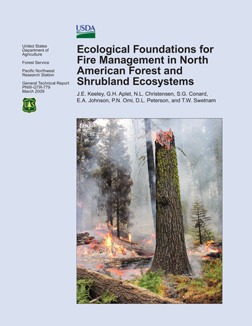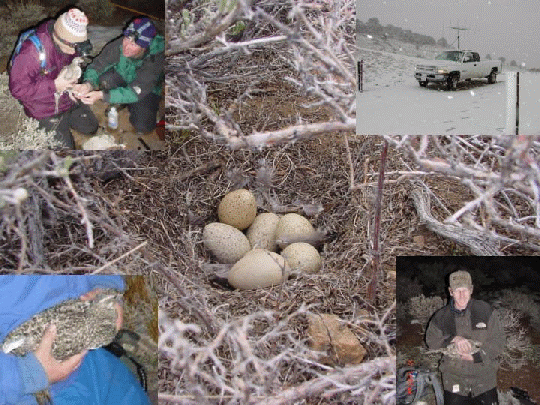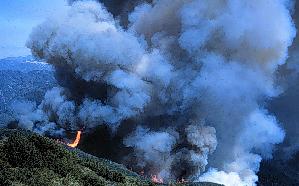- Home
- About S&T
- Taxa/Organisms
- Ecosystems
- Issues
- Methods & Tools
- Reports & Publications
- Location
- Search
Publisher: USGS | Science Center: Forest and Rangeland Ecosystem Science Center (FRESC, Corvallis) | Format: URL
sagemap.wr.usgs.gov — SAGEMAP - Spatial Data for Sage Grouse and Shrubsteppe Systems is needed for research and management of sage grouse and sagebrush steppe habitats in the western United States. This website is a product of the NBII Great Basin Information Project. Find out more from this resource on sage grouse as endangered species, habitat information, More...

March 2009 | Publisher: USGS | Science Center: Western Ecological Research Center (WERC, Sacramento) | Format: .PDF
www.werc.usgs.gov — Fire occurs in many North American ecosystems, and most of these systems are resilient to fires that occur within a broad range of variability in frequency and intensity. In a recent USFS publication (General Technical Report PNW-GTR-779, ), USGS scientist Jon Keeley led a team of scientists from various agencies and academic institutions in More...

November 2007 | Publisher: Academic Institution (Sage-grouse Restoration Project (SGRP), Utah State University) | Format: .PDF
sgrp.usu.edu — The greater sage-grouse (Centrocercus urophasianus) and the Gunnison sage-grouse (C. minimus) are species of concern because of their population declines and shrinking geographic distributions. Of continuing interest is the question of population abundance and trends. This publication answers the questions that deal with sage-grouse population, More...

July 2007 | Publisher: Other (Ecological Society of America (ESA) Journal) | Format: URL
www.esajournals.org — Periodic wildfire maintains the integrity and species composition of many ecosystems, including the Mediterranean-climate shrublands of California. However, human activities alter natural fire regimes, which can lead to cascading ecological effects. Increased human ignitions at the wildland-urban interface (WUI) have recently gained attention, but More...

1999 | Publisher: USGS | Science Center: Fort Collins Science Center (FORT, Ft. Collins) | Format: URL
www.fort.usgs.gov — A quasi-experimental situation exists in Rocky Mountain National Park, where elk (Cervus elaphus) populations have increased 3-fold since 1968 following their release from artificial controls within the park. Increases in elk habitat use and decreases in deer habitat use were observed. Significant increases in cover of mosses and lichens occurred More...

Publisher: USGS | Science Center: Western Ecological Research Center (WERC, Sacramento) | Format: URL
www.werc.usgs.gov — This web resource addresses the positive relationship between cheatgrass (Bromus tectorum) and fire frequency as a major concern for land managers in semi-arid shrublands throughout western North America, particularly in Great Basin sagebrush steppe. Management tools are needed to break this cycle, and in this project we will evaluate the use of More...

Publisher: USGS | Science Center: Western Ecological Research Center (WERC, Sacramento) | Format: URL
www.werc.usgs.gov — This resource provides an overview of the research on ways to prevent invasive annual grass invasions and restore invaded habitats, which has independently and repeatedly been identified by all land management agencies as a top national research priority. Annual grasses have invaded a number of shrub and forest ecosystems in western North America More...

Publisher: USGS | Science Center: Western Ecological Research Center (WERC, Sacramento) | Format: URL
www.werc.usgs.gov — The sage grouse that occupies the Mono County area is described as the eastern subspecies of the greater sage-grouse (Centrocercus urophasianus urophasianus). The greater sage-grouse (Centrocercus urophasianus) is found in sagebrush (Artemisia spp.) dominated habitats across western North America. Sage grouse populations have declined dramatically More...

Publisher: USGS | Science Center: Western Ecological Research Center (WERC, Sacramento) | Format: URL
www.werc.usgs.gov — Fire Ecology Research is conducted in the Sierra Nevada forests, California shrublands, and the Mojave and Sonoran Deserts. Information obtained from these studies will lower the risk to human life and property, and help safeguard the stability and diversity of Pacific Southwest ecosystems. Wildland fires are an important ecosystem process More...
